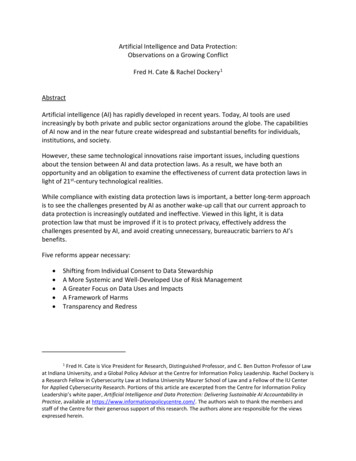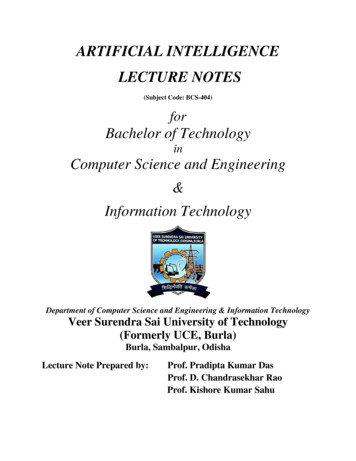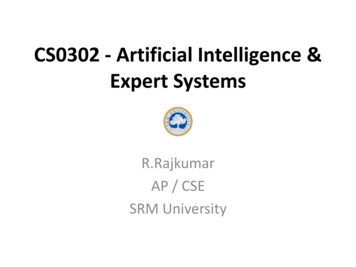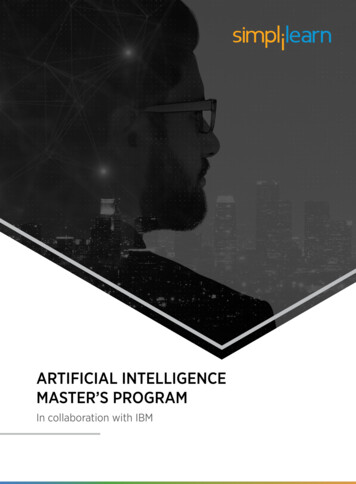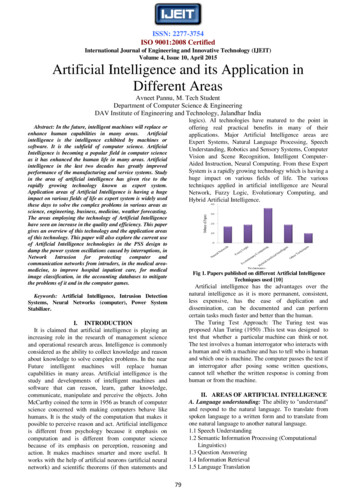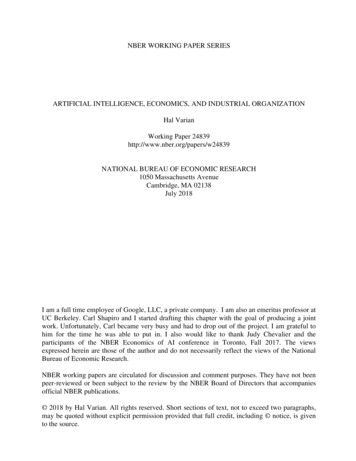
Transcription
NBER WORKING PAPER SERIESARTIFICIAL INTELLIGENCE, ECONOMICS, AND INDUSTRIAL ORGANIZATIONHal VarianWorking Paper 24839http://www.nber.org/papers/w24839NATIONAL BUREAU OF ECONOMIC RESEARCH1050 Massachusetts AvenueCambridge, MA 02138July 2018I am a full time employee of Google, LLC, a private company. I am also an emeritus professor atUC Berkeley. Carl Shapiro and I started drafting this chapter with the goal of producing a jointwork. Unfortunately, Carl became very busy and had to drop out of the project. I am grateful tohim for the time he was able to put in. I also would like to thank Judy Chevalier and theparticipants of the NBER Economics of AI conference in Toronto, Fall 2017. The viewsexpressed herein are those of the author and do not necessarily reflect the views of the NationalBureau of Economic Research.NBER working papers are circulated for discussion and comment purposes. They have not beenpeer-reviewed or been subject to the review by the NBER Board of Directors that accompaniesofficial NBER publications. 2018 by Hal Varian. All rights reserved. Short sections of text, not to exceed two paragraphs,may be quoted without explicit permission provided that full credit, including notice, is givento the source.
Artificial Intelligence, Economics, and Industrial OrganizationHal VarianNBER Working Paper No. 24839July 2018JEL No. L0ABSTRACTMachine learning (ML) and artificial intelligence (AI) have been around for many years.However, in the last 5 years, remarkable progress has been made using multilayered neuralnetworks in diverse areas such as image recognition, speech recognition, and machine translation.AI is a general purpose technology that is likely to impact many industries. In this chapter Iconsider how machine learning availability might affect the industrial organization of both firmsthat provide AI services and industries that adopt AI technology. My intent is not to provide anextensive overview of this rapidly-evolving area, but instead to provide a short summary of someof the forces at work and to describe some possible areas for future research.Hal VarianGoogleMountain View, CA 94043hal@sims.berkeley.edu
Artificial Intelligence, Economics, andIndustrial OrganizationHal Varian1Nov 2017Revised June 2018IntroductionMachine learning overviewWhat can machine learning do?What factors are scarce?Important characteristics of dataData ownership and data accessDecreasing marginal returnsStructure of ML-using industriesMachine learning and vertical integrationFirm size and boundariesPricingPrice differentiationReturns to scaleSupply side returns to scaleDemand side returns to scaleLearning by doingAlgorithmic collusionStructure of ML-provision industriesPricing of ML servicesPolicy questionsSecurityPrivacyI am a full time employee of Google, LLC, a private company. I am also an emeritus professor at UCBerkeley. Carl Shapiro and I started drafting this chapter with the goal of producing a joint work.Unfortunately, Carl became very busy and had to drop out of the project. I am grateful to him for the timehe was able to put in. I also would like to thank Judy Chevalier and the participants of the NBEREconomics of AI conference in Toronto, Fall 2017.1
ExplanationsSummaryReferencesIntroductionMachine learning (ML) and artificial intelligence (AI) have been around for many years.However, in the last 5 years, remarkable progress has been made using multilayered neuralnetworks in diverse areas such as image recognition, speech recognition, and machinetranslation. AI is a general purpose technology that is likely to impact many industries. In thischapter I consider how machine learning availability might affect the industrial organization ofboth firms that provide AI services and industries that adopt AI technology. My intent is not toprovide an extensive overview of this rapidly-evolving area, but instead to provide a shortsummary of some of the forces at work and to describe some possible areas for future research.Machine learning overviewImagine we have a set of digital images along with a set of labels that describe what is depictedin those images---things like cats, dogs, beaches, mountains, cars, or people. Our goal is touse this data to train a computer to learn how to predict labels for some new set of digitalimages. For a nice demonstration see cloud.google.com/vision where you can upload a photoand retrieve a list of labels appropriate for that photo.The classical approach to machine vision involved creating a set of rules that identified pixels inthe images with human-recognizable features such as color, brightness, and edges and thenuse these features to predict labels. This “featurization” approach had limited success. Themodern approach is to work directly with the raw pixels using layered neural networks. This hasbeen remarkably successful, not only with image recognition but also with voice recognition,language translation and other traditionally difficult machine learning tasks. Nowadayscomputers can outperform humans in many of these tasks.This approach, called deep learning , requires 1) labeled data for training, 2) algorithms for theneural nets, and 3) special purpose hardware to run the algorithms. Academics and techcompanies have provided training data and algorithms for free, and compute time in cloudcomputing facilities is available for a nominal charge.1. Training data . Examples are OpenImages, a 9.5 million dataset of labeled images andthe Stanford Dog Dataset, 20,580 images of 120 breeds of dogs.
2. Algorithms. Popular open source packages include TensorFlow, Caffe, MXNet, andTheano.3. Hardware. CPUs (central processing units), GPUs (graphical processing units), andTPUs (Tensor processing units), are available via cloud computing providers. Thesefacilities allow the user to organize vast amounts of data which can be used to trainmachine learning models.Of course, it is also important to have experts who can manage the data, tune the algorithms,and nurture the entire process. These skills are in fact, the main bottleneck at the moment, butuniversities are rapidly rising to the challenge of providing the education and training necessaryto create and utilize machine learning.In addition to machine vision, the deep learning research community has made dramaticadvances in speech recognition and language translation. These areas also have been able tomake this progress without the sorts of feature identification that had been required for previousML systems.Other types of machine learning are described in the Wikipedia entry on this topic. Oneimportant form of machine learning is reinforcement learning . This is is a type of learning wherea machine optimizes some task such as winning at chess or video games. One example ofreinforcement learning is a multi-armed bandit, but there are many other tools used, some ofwhich involve deep neural nets.Reinforcement learning is a type of sequential experimentation and is therefore fundamentallyabout causality: moving a particular chess piece from one position to another causes theprobability of a win to increase. This is unlike passive machine learning algorithms that use onlyobservational data.Reinforcement learning can also be implemented in an adversarial context. For example, inOctober 2017 DeepMind announced a machine learning system, Alpha Go 0, that developed ahighly effective strategy by playing Go games against itself!The model of “self-taught machine learning” is an interesting model for game theory. Can deepnetworks learn to compete and/or learn to cooperate with other players entirely their own? Willthe learned behavior look anything like the equilibria for game-theoretic models we have built?So far these techniques have been applied primarily to full information games. Will they work ingames with incomplete or asymmetric information?There is a whole sub-area of AI known as adversarial AI (or adversarial ML) that combinesthemes from AI, grame theory, and computer security that examines ways to attack and defendAI systems. Suppose, for example, that we have a trained image recognition system thatperforms well on average. What about its worst-case performance? It turns out that there areways to create images that appear innocuous to humans that will consistently fool the ML
system. Just as “optical illusions” can fool humans, these “ML illusions” can fool machines.Interestingly, the optimal illusions for humans and machines are very different. For someexamples, see [ Goodfellow et al 2017 ] for illustrative examples and [ Kurakin, et al 2016 ] for atechnical report. Computer science researchers have recognized the connections with gametheory; in my opinion this area offers many interesting opportunities for collaboration. See, forexample, [ Sreevallabh and Liu 2017 ].What can machine learning do?The example of machine learning presented in the popular press emphasize novel applications,such as winning at games such as chess, go, and pong. However, there are also manypractical applications that use machine learning to solve real-world business problems. A goodplace to see what kinds of problem ML can solve is Kaggle . This company sets up machinelearning competitions. A business or other organization provide some data, a problemstatement, and some prize money. Data scientists then use the data to solve the problemposed. The winners get to take home the prize money. There are well over 200 competitionson the site; here are a few of the most recent. Passenger Threats: Improve accuracy of Homeland Security threat recognition; 1,500,000Home Prices; Improve accuracy of Zillow’s home price prediction; 1,200,000Traffic to Wikipedia Pages; Forecast future traffic to Wikipedia pages; 25,000Personalized Medicine; Predict effect of Genetic Variants to enable PersonalizedMedicine; 15,000Taxi Trip Duration; Predict total ride duration of taxi trips in New York; 30,000Product Search Relevance; Predict relevance of search results on homedepot.com; 40,000Clustering Questions; Can you identify question pairs that have the same intent?; 25,000Cervical cancer screening; Which cancer treatments will be most effective?; 100,000Click Prediction; Can you predict which recommended content each user will click?; 25,000Inventory Demand; Maximize sales and minimize returns of bakery goods; 25,000What is nice is that these are real questions and real money from organizations that want realanswers for real problems. Kaggle gives concrete examples of how machine learning can beapplied for practical business questions.2Disclosure: I was an angel investor in Kaggle up till mid-2017 when it was acquired by Google. Sincethen I have had no financial interest in the company.2
What factors are scarce?Suppose you want to deploy a machine learning system in your organization. The firstrequirement is to have a data infrastructure that collects and organizes the data of interest---adata pipeline . For example, a retailer would need a system that can collect data at point ofsale, and then upload it to a computer that can then organize the data into a database. Thisdata would then be combined with other data, such as inventory data, logistics data, andperhaps information about the customer. Constructing this data pipeline is often the mostlabor intensive and expensive part of building a data infrastructure, since different businessesoften have idiosyncratic legacy systems that are difficult to interconnect.Once the data has been organized, it can be collected together to in a data warehouse. Thedata warehouse allows easy access to systems that can manipulate, visualize and analyze thedata.Traditionally, companies ran their own data warehouses which required not only purchase ofcostly computers, but also required human system administrators to keep everything functioningproperly. Nowadays, it is more and more common to store and analyze the data in a cloudcomputing facility such as Amazon Web Services, Google Cloud Platform, or Microsoft AzureCloud.The cloud provider takes care of managing and updating the hardware and software necessaryto host the databases and tools for data analysis. From an economic point of view, what isinteresting is that what was previously a fixed cost to the users (the data center) has now turnedinto a variable cost (buying services from a data center). An organization can purchase virtuallyany amount of cloud services, so even small companies can start at a minimal level and becharged based on usage. Cloud computing is much more cost effective than owning your owndata center since compute and data resources can be purchased on an as-needed basis.Needless to say, most tech startups today use a cloud provider for their hardware, software, andnetworking needs.Cloud providers also offer various machine learning services such as voice recognition, imagerecognition, translation, and so on. These systems are already trained by the vendor and canbe put to immediate use by customers. It is no longer necessary for each company to developits own software for these tasks.Competition among the cloud providers is intense. Highly detailed and specific imagerecognition capabilities are offered at a cost of a tenth-of-a-cent per image or less, with volumediscounts on top of that price.A user may also have idiosyncratic data relevant to its own business like the point-of-sale datamentioned above. The cloud provider also offers up-to-date, highly optimized hardware and
software than implements popular machine learning algorithms. This allows the user immediateaccess to high powered tools.providing that they have the expertise to use them.If the hardware, software, and expertise are available, all that is needed is the labeled data.There are a variety of ways to acquire such data. As By-Product of Operations. Think of a chain of restaurants where some performbetter than others, and management may be interested in factors that are associatedwith performance. Much of the data in the Kaggle competitions mentioned above aregenerated as a byproduct of day-to-day operations.Web scraping. This is a commonly used way to extract data from websites. There is alegal debate about what exactly is permitted with respect to both the collection of dataand how it is used. The debate is too complex to discuss here, but the Wikipedia entryon Web scraping is good. An alternative is to use data that others have scraped. Forexample, the Common Crawl database contains petabytes of data compiled over 8 yearsof web crawling.Offering a Service. When Google started its work on voice recognition, it had noexpertise and no data. It hired the expertise and they came up with the idea of avoice-input telephone directory as a way to acquire data. Users would say “Joe’s Pizza,University Avenue, Palo Alto” and the system would respond with a phone number. Thedigitized question and the resulting user choices were uploaded to the cloud andmachine learning was used to evaluate the relationship between Google’s answer andthe user action---e.g., to call the suggested number. The ML training used data frommillions of individual number requests and learned rapidly. ReCAPTCHA applies asimilar model where humans label images to prove they are human and not a simple bot.Hiring Humans to Label Data. Mechanical Turk and other systems can be used to paypeople to label data. See Hutson (2017).Buying Data from Provider. There are many providers of various sorts of data such asmail lists, credit scores, and so on.Sharing Data. It may be mutually advantageous to parties to share data. This iscommon among academic researchers. The Open Images Dataset contains about 9million labeled images contributed by universities and research labs. Sharing may bemandated for a variety reasons, such as concerns for public safety. Examples are blackbox from airplanes, or medical data on epidemics.Data from Governments. There are vast amounts of data available from governments,universities, research labs and non-governmental agencies.Data from Cloud Providers. Many Cloud providers also provide public datarepositories. See, e.g., Google Public Datasets , Google Patents Public Dataset , orAWS Public Datasets .Computer generated data. The Alpha Go 0 system mentioned earlier generated itsown data by playing Go games against itself. Machine vision algorithms can be trainedusing “synthetic images” which are actual images that have been shifted, rotated, andscaled in various ways.
Important characteristics of dataInformation science uses the concept of a “data pyramid” to depict the relationship betweendata, information, and knowledge. Some system has to collect the raw data, and subsequentlyorganize and analyze that data in order to turn it into information---something such as a textualdocument image that can be understood by humans. Think of the pixels in an image beingturned into human-readable labels. In the past this was done by humans; in the future moreand more of this will be done by machines.This insights from the information can then turned into knowledge, which generally is embodiedin humans. We can think of data being stored in bits, information stored in documents, andknowledge stored in humans. There are well developed markets and regulatory environmentsfor information (books, articles, web pages, music, videos) and for knowledge (labor markets,consultants). Markets for data---in the sense of unorganized collections of bits---are not asdeveloped. Perhaps this is because raw data is often heavily context dependent and is not veryuseful until it is turned into information.Data ownership and data accessIt is said that “data is the new oil”. Certainly, they are alike in one respect: both need to berefined in order to be useful. But there is an important distinction: oil is a private good andconsumption of oil is rival : if one person consumes oil, there is less available for someone elseto consume. But data is non-rival: one person’s use of data does not reduce or diminishanother person’s use.So instead of focusing on data “ownership”---a concept appropriate for private goods---we reallyshould think about data access. Data is rarely “sold” in the same way private goods are sold,rather it is licensed for specific uses. Currently there is a policy debate in Europe about “who
should own autonomous vehicle data?” A better question is to ask “who should have access toautonomous vehicle data and what can they do with it?” This formulation emphasizes thatmany parties can simultaneously access autonomous vehicle data. In fact, from the viewpointof safety it seems very likely that multiple parties should be allow to access autonomous vehicledata. There could easily be several data collection points in a car: the engine, the navigationsystem, mobile phones in rider’s pockets, and so on. Requiring exclusivity without a goodreason for doing so would unnecessarily limit what can be done with the data.Ross Anderson’s description of what happens when there is an aircraft crash makes animportant point illustrating why it may be appropriate to allow several parties to access data.“When an aircraft crashes, it is front page news. Teams of investigators rush to thescene, and the subsequent enquiries are conducted by experts from organisations with awide range of interests --- the carrier, the insurer, the manufacturer, the airline pilots'union, and the local aviation authority. Their findings are examined by journalists andpoliticians, discussed in pilots' messes, and passed on by flying instructors. In short, theflying community has a strong and institutionalised learning mechanism. Anderson[1993].Should we not want the same sort of learning mechanism for autonomous vehicles?Some sorts of information can be protected by copyright. But in the US raw data such as atelephone directory is not protected by copyright. (See Wikipedia entry on the legal case FeistPublications, Inc v Rural Telephone Service Co. )Despite this, data providers may compile some data and offer to license it on certain terms toother parties. For example, there are several data companies that merge U.S. Census datawith other sorts of geographic data and offer to license this data to other parties. Thesetransactions may prohibit resale or relicensing. Even though there is no protectable intellectualproperty, the terms of of the contract form a private contract which can be enforced by courts, aswith any other private contract.Decreasing marginal returnsFinally, it is important to understand that data typically exhibits decreasing returns to scale likeany other factor of production. The same general principle applies for machine learning. Figure1 shows how the accuracy of the Stanford dog breed classification behaves as the amount oftraining data increases. As one would expect accuracy improves as the number of trainingimages increases, but it does so at a decreasing rate.
Source: igure 2 shows how the error rate in the ImageNet competition has declined over the lastseveral years. An important fact about this competition is that the number of training and testobservations have been fixed during this period. This means that the improved performance ofthe winning systems cannot depend on sample size since it has been constant. Other factorssuch as improved algorithms, improved hardware, and improved expertise have been muchmore important than the number of observations in the training data.Peter Eckersley, Yomna Nasser et al (2017), EFF AI Progress Measurement Project,https://eff.org/ai/metrics
Structure of ML-using industriesAs with any new technology, the advent of machine learning raises several economic questions. Which firms and industries will successfully adopt machine learning?Will we see heterogeneity in the timing of adoption and the ability to use ML effectively?Can later adopters imitate early adopters?What is the role of patents, copyright, and trade secrets?What is the role of geography in adoption patterns?Is there a large competitive advantage for early, successful adopters?[McKinsey 2017] recently conducted a survey of 3000 “AI Aware” C-level executives aboutadoption readiness. Of these executives, 20% are “serious adopters, 40% are “experimenting”,and 28% feel their firms “lack the technical capabilities” to implement ML. McKinsey identifieskey enablers of adoption to be leadership, technical ability, and data access. Figure 3 breaksdown how ML adoption varies across economic sectors. Not surprisingly, sectors such astelecom, tech, and energy are ahead of less tech-savvy sectors such as construction and travel.Source McKinsey (2017)
Machine learning and vertical integrationA key question for industrial organization is how machine learning tools and data can becombined to create value? Will this happen within or across corporate boundaries? Will MLusers develop their own ML capabilities or purchase ML solutions from vendors? This is theclassic make vs. buy question that is the key to understanding much of real-world industrialorganization.As mentioned earlier, cloud vendors provide integrated hardware and software environments fordata manipulation and analysis. They also offer access to public and private databases,provide labeling services, consulting, and other related services which enable one-stopshopping for data manipulation and analysis. Special purpose hardware provided by cloudproviders such as GPUs and TPUs have become key technologies for differentiating providerservices.As usual there is a tension between standardization and differentiation. Cloud providers arecompeting intensely to provide standardized environments that can be easily maintained. Atthe same time, they want to provide services that differentiate their offerings from competitors.Data manipulation and machine learning are natural areas to compete with respect to productspeed and performance.Firm size and boundariesWill ML increase or decrease minimum efficient scale? The answer depends on the relationshipbetween fixed costs and variable costs. If firms have to spend significant amounts to developcustomized solutions to their problems, we might expect that fixed costs are significant andfirm size must be large to amortize those costs. On the other hand, if firms can buy off-the-shelfservices from cloud vendors, we would expect that fixed costs and minimum efficient scale to besmall.Suppose, for example, that an oil change service would like to greet returning customers byname. They can accomplish this using a database that joins license plate numbers withcustomer names and service history. It would be prohibitively expensive for a small provider towrite the software to enable this, so only the large chains could provide such services. On theother hand, a third party might develop a smartphone app that could provide this service for anominal cost. This service might allow minimum efficient scale to decrease. The sameconsiderations apply for other small service providers such as restaurants, dry cleaners, orconvenience stores.
Nowadays new startups are able to outsource a variety of business processes since there are aseveral providers of business services. Just as fast-food providers could perfect a model with asingle establishment and then go national, business service companies can build systems onceand replicate them globally.Here is a list of how a startup might outsource a dozen business processes. Fund its project on Kickstarter Hire employees using LinkedIn Cloud cloud computing and network from Google, Amazon, MicroSoft Use open source software like Linux, Python, Tensorflow, etc Manage its software using GitHub Become a micro-multinational and hire programmers from abroad Set up a Kaggle competition for machine learning Use Skype, Hangouts, Google Docs, etc for team communication Use Nolo for legal documents (company, patents, NDAs) Use QuickBooks for accounting. Use AdWords, Bing, Facebook for marketing Use Salesforce for customer relations Use ZenDesk for user supportThis is only a partial list. Most startups in Silicon Valley and San Francisco avail themselves ofseveral of these business-process services. By choosing standardizing business processes,the startups can focus on their core competency and purchases services as necessary as theyscale. One would expect to see more entry and more innovation as a result of the availability ofthese business-process services.PricingThe availability of cloud computing and machine learning offers lots of opportunities to adjustprices based on customer characteristics. Auctions and other novel pricing mechanism can beimplemented easily. The fact that prices can be so easily adjust implies that various forms ofdifferential pricing can be implemented. However, it must be remembered that customers arenot helpless; they can also avail themselves of enhanced search capabilities. For example,airlines can adopt strategies that tie purchase price to departure date. But services can becreated that reverse-engineer the airline algorithms and advise consumers about when topurchase ; See Etzione et al [2003] for an example. See Acquisti and Varian [2005] for a
theoretical model of how consumers might respond to attempts to base prices on consumerhistory and how the consumers can respond to such attempts.Price differentiationTraditionally, price differentiation has been classified into three categories:1. First degree (personalized),2. Second degree (versioning: same price menu for all consumers, but prices vary withrespect to quantity or quality),3. Third degree (group pricing based on membership)Fully personalized pricing is unrealistic, but prices based on fine grained features of consumersmay well be feasible, so the line between third degree and first degree is becoming somewhatblurred. Shiller [2014] and Dube [2017] have investigated how much consumer surplus can beextracted using ML models.Second-degree price discrimination can also be viewed as pricing by group membership, butrecognizing the endogeneity of group membership and behavior. Machine learning usingobservational data will be of limited help in designing such pricing schemes. However,reinforcement learning techniques such as multi-armed bandits may be useful.According to most non-economists the only thing worse that price differentiation is pricediscrimination! However, most economists recognize that price differentiation is often beneficialfrom both an efficiency and an equity point of view. Price differentiation allows markets to beserved that would otherwise not be served and often those unserved markets involvelow-income consumers.DellaVigna and Gentzkow (2017) suggest that “.the uniform pricing we documentsignificantly increases the prices paid by poorer households relative to the rich.” This effect canbe substantial. The authors show that “consumers of [food] stores in the lowest income decilepay about 0.7 percent higher prices than they would pay under flexible pricing, but consumers ofstores in the top income decile pay about 9.0 percent lower prices than under flexible pricing.”Returns to scaleThere are at least 3 types of returns to scale that could be relevant for machine learning.1. Classical supply side returns to scale (decreasing average cost)2. Demand side returns to scale (network effects)3. Learning by doing (improvement in quality or decrease in cost due to experience).
Supply side returns to scaleIt might seem like software is the paradigm case of supply side returns to scale: there is a largefixed cost of developing the software, and a small variable cost of distributing it. But if wecompare this admittedly simple model to the real world, there is an immediate problem.Software development is not a one-time operation; almost all software is updated and improvedover time.
Machine learning (ML) and artificial intelligence (AI) have been around for many years. However, in the last 5 years, remarkable progress has been made using multilayered neural networks in diverse areas such as image recognition, speech recognition, and machine translation. AI is a gen



